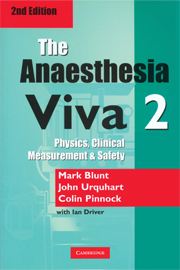Book contents
- Frontmatter
- Foreword to the First Edition
- Preface to the Second Editions
- Contents
- Physics, Clinical Measurement & Safety
- Clinical Anaesthesia
- Example 1
- Example 2
- 6 Example 3
- 7 Example 4
- Example 5
- Example 6
- Example 7
- Example 8
- Example 9
- Example 10
- Example 11
- Example 12
- Example 13
- Example 14
- Appendix 1
- Appendix 2
- Index
Example 8
Published online by Cambridge University Press: 05 February 2015
- Frontmatter
- Foreword to the First Edition
- Preface to the Second Editions
- Contents
- Physics, Clinical Measurement & Safety
- Clinical Anaesthesia
- Example 1
- Example 2
- 6 Example 3
- 7 Example 4
- Example 5
- Example 6
- Example 7
- Example 8
- Example 9
- Example 10
- Example 11
- Example 12
- Example 13
- Example 14
- Appendix 1
- Appendix 2
- Index
Summary
Scenario
You are asked to anaesthetise a patient with porphyria. What is the condition, and how will you conduct the anaesthetic?
There are two groups of porphyria; erythropoetic and hepatic. Anaesthesia does not induce erythropoetic forms. Discuss the condition first and then outline a technique that you would be prepared to administer.
The clinical effects of porphyria are due to overproduction of haem precursors, which are highly toxic, due to the overactivity of a small, readily induced enzyme. The enzyme is d-aminolaevulinic acid (ALA) synthetase, and the disease is due to a relative deficiency of another enzyme later on in the synthetic process, thus allowing accumulation of intermediate metabolites. The position of the deficient enzyme predicts the type of precursor to accumulate and the pattern of the disease. Smaller intermediates cross the blood-brain barrier and cause neuropsychiatric disturbance, while larger ones cause cutaneous manifestations.
The two important conditions are Acute Intermittent Porphyria (AIP) and Variegate Porphyria (VP). Both are inherited in an autosomal dominant form. Both are precipitated by induction of ALA synthetase by pregnancy, dieting, and drugs of importance such as barbiturates, steroids, sulphonamides and griseofulvin. Management of an attack involves analgesia, carbohydrate loading, beta-blockade, fluids and haematin solutions to suppress ALA synthetase activity.
▪ Acute Intermittent Porphyria: this is due to a deficiency of uroporphyrinogen I synthase, allowing accumulation of small metabolites: thus the picture is of abdominal pain, neuropathy, and psychosis. AIP is common in Scandinavia and diagnosis is made by finding ALA in the urine.
[…]
- Type
- Chapter
- Information
- The Anaesthesia Viva , pp. 106 - 108Publisher: Cambridge University PressPrint publication year: 2003

